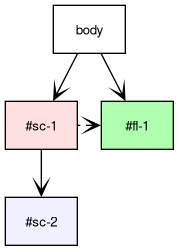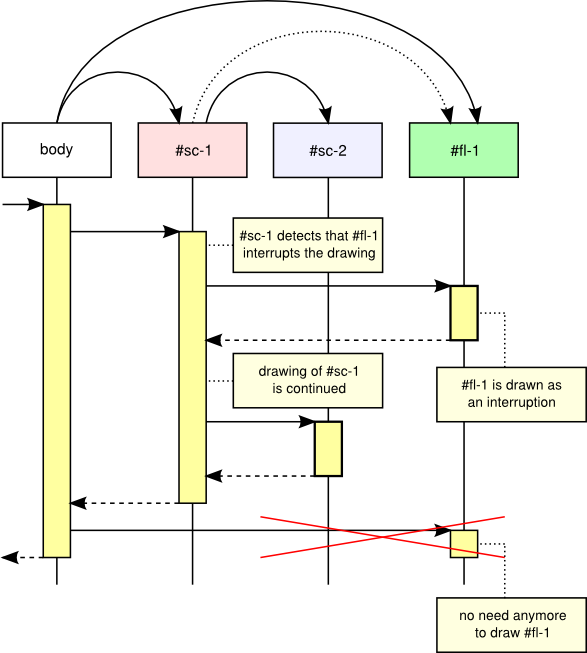Describing the problem
Without interrupting drawing (which is described below), a widget can define the order in which its parts (background, non-widget content, child widgets, etc.) are drawn, but it must be drawn as a whole. There are situations when this is not possible.
Consider the following simple HTML document:
<head>
<style>
#sc-1 { position: relative; z-index: 1; background: #ffe0e0; }
#fl-1 { float: right; background: #b0ffb0; }
#sc-2 { position: relative; z-index: 1; background: #f0f0ff; }
</style>
</head>
<body>
<div id="sc-1">
<div id="fl-1">
Float, line 1/3<br/>
Float, line 2/3<br/>
Float, line 3/3
</div>
Stacking Context 1
<div id="sc-2">Stacking Context 2</div>
</div>
</body>
The rendering will look like this:

Note the missing "Float, line 2/3" of element #fl-1, which is covered by element #sc-2.
As described in Handling Elements Out Of Flow, it has to be distinguished between the container hierarchy (equivalent to the hierarchy of dw::core::Widget.) and the the generator hierarchy. In the following diagram, the former is represented by solid lines, the latter by dotted lines:

The drawing order of the four elements (represented by widgets) is:
- body,
- #sc-1,
- #fl-1,
- #sc-2.
Since
- #sc-2 is a child of #sc-1, but
- #fl-1 is a child of the body, and
- a widget can only draw its descendants (not necessary children, but drawing siblings is not allowed),
#sc-1 cannot be drawn as a whole; instead drawing is interrupted by #fl-1. This means:
- the background and text of #sc-1 is drawn;
- drawing of #sc-1 is interrupted by #fl-1 (see below for details),
- drawing of #sc-1 is continued, by drawing #sc-2.
The exact control flow is described in this sequence diagram:

When is drawing interrupted?
A widget out of flow is regarded as part of the stacking context (see Handling stacking contexts) of its generator (in the example above: #fl-1 is part of the stacking context stablished by #sc-1, not the one established by body). For this reason, a widget out of flow must, in some cases, drawn while the gerator is drawn, as an interruption. The exact rule:
A widget out of flow must be drawn as an interruption (while the generator* is drawn) if the stacking context of the generator (to which this widget belongs) is in front of the stacking context of the container (the parent widget).
See dw::oof::OOFAwareWidget::doesWidgetOOFInterruptDrawing.
How does interruption of drawing work?
When a widget detects that an other widget should be drawn as interruption (see above), it calls dw::core::Widget::drawInterruption, which
- draws the widget within another "context" (area and reference widget); for this the original drawing area (dw::core::DrawingContext::getToplevelArea) is used.
- Using dw::core::DrawingContext::addWidgetDrawnAsInterruption, and checking later with dw::core::DrawingContext::hasWidgetBeenDrawnAsInterruption prevents these widgets from being drawn twice.